The static uninterruptible power supply market is expected to grow from USD 1.8 billion in 2025 to USD 2.7 billion by 2035, reflecting expanding demand for continuous power support across critical applications. Growth dynamics in the early phase are supported by the rising number of commercial facilities, office complexes, data handling centers, and healthcare institutions that require stable and interruption-free electricity. Static UPS systems are increasingly integrated into building infrastructure to prevent downtime, protect sensitive electronic equipment, and ensure operational continuity during grid disturbances. Line interactive UPS units are gaining rapid traction due to their cost-effectiveness, installation flexibility, and suitability for medium-load environments. This aligns with the increase in distributed power systems and localized backup configurations.
In the later years of the forecast period, industrial, manufacturing, and utility sectors are expected to expand the adoption of higher-capacity static UPS systems capable of supporting larger loads and automated operational workflows. The growing use of digital control architectures, real-time monitoring platforms, and remote diagnostics is enhancing performance reliability and lifecycle management. Residential applications are also contributing to incremental demand as households seek protection from power fluctuations and outages linked to weather events and regional grid instability.
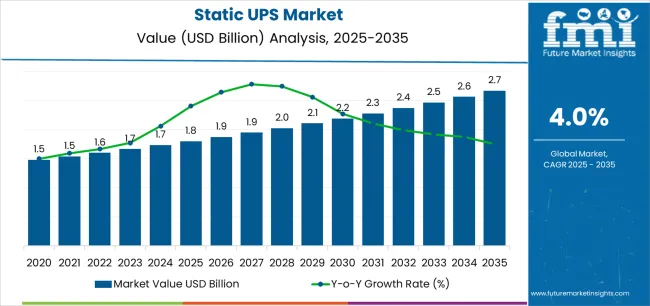
The latter half (2030-2035) will witness sustained growth from USD 2.1 billion to USD 2.7 billion, representing an addition of USD 0.6 billion or 67% of the decade's expansion. This period will be defined by mass market penetration of specialized true online UPS designs, integration with comprehensive power management platforms, and seamless compatibility with existing electrical infrastructure. The market trajectory signals fundamental shifts in how facility managers approach power protection optimization and equipment reliability management, with participants positioned to benefit from sustained demand across multiple topology types and application segments.
The Static UPS market demonstrates distinct growth phases with varying market characteristics and competitive dynamics. Between 2025 and 2030, the market progresses through its technology adoption phase, expanding from USD 1.8 billion to USD 2.1 billion with steady annual increments averaging 4.0% growth. This period showcases the transition from basic power protection formulations to advanced true online UPS systems with enhanced power conditioning capabilities and integrated monitoring systems becoming mainstream features.
The 2025-2030 phase adds USD 0.3 billion to market value, representing 33% of total decade expansion. Market maturation factors include standardization of power protection and facility management protocols, declining component costs for specialized UPS formulations, and increasing industry awareness of backup power benefits reaching 95-98% power protection effectiveness in commercial and industrial applications. Competitive landscape evolution during this period features established power equipment manufacturers like Eaton and Vertiv expanding their UPS portfolios while specialty manufacturers focus on advanced topology development and enhanced reliability capabilities.
From 2030 to 2035, market dynamics shift toward advanced topology integration and global deployment expansion, with growth continuing from USD 2.1 billion to USD 2.7 billion, adding USD 0.6 billion or 67% of total expansion. This phase transition centers on specialized UPS topology systems, integration with automated power management networks, and deployment across diverse commercial and industrial scenarios, becoming standard rather than specialized applications. The competitive environment matures with focus shifting from basic power protection capability to comprehensive facility optimization systems and integration with energy monitoring platforms.
| Metric | Value |
|---|---|
| Market Value (2025) | USD 1.8 billion |
| Market Forecast (2035) | USD 2.7 billion |
| Growth Rate | 4.0% CAGR |
| Leading Technology | True online Topology Type |
| Primary Application | Commercial Application Segment |
The market demonstrates strong fundamentals with true online UPS systems capturing a dominant share through advanced power protection and conditioning optimization capabilities. Commercial applications drive primary demand, supported by increasing facility construction and reliable power technology requirements. Geographic expansion remains concentrated in developed markets with established electrical infrastructure, while emerging economies show accelerating adoption rates driven by industrial expansion and rising power quality standards.
Market expansion rests on three fundamental shifts driving adoption across the commercial, industrial, and residential sectors. First, power reliability demand creates compelling operational advantages through static UPS systems that provide immediate equipment protection and continuity without compromising facility operations, enabling managers to meet stringent uptime standards while maintaining operational productivity and reducing equipment damage risk. Second, facility infrastructure modernization accelerates as building operators worldwide seek advanced UPS systems that complement traditional electrical processes, enabling precise power conditioning and protection that align with industry standards and operational regulations.
Third, critical equipment protection drives adoption from data centers and telecommunications operators requiring effective power backup solutions that maximize operational continuity while maintaining facility productivity during outages and power quality events. However, growth faces headwinds from initial investment cost challenges that vary across UPS suppliers regarding the pricing of power electronics and battery systems, which may limit adoption in cost-sensitive environments. Technical limitations also persist regarding battery maintenance requirements and replacement costs that may reduce effectiveness in long-term deployment scenarios, which affect total cost of ownership and operational requirements.
The static UPS market represents a specialized yet critical power protection opportunity driven by expanding global commercial construction, facility infrastructure modernization, and the need for superior equipment protection in diverse applications. As facility managers worldwide seek to achieve 95-98% uptime effectiveness, reduce equipment damage, and integrate advanced UPS systems with automated platforms, static UPS solutions are evolving from basic backup devices to sophisticated power management systems ensuring operational continuity and reliability leadership.
The market's growth trajectory from USD 1.8 billion in 2025 to USD 2.7 billion by 2035 at a 4.0% CAGR reflects fundamental shifts in power quality requirements and facility protection optimization. Geographic expansion opportunities are particularly pronounced in Asia Pacific markets, while the dominance of true online UPS systems and commercial applications provides clear strategic focus areas.
Strengthening the dominant true online segment through enhanced power conditioning, superior reliability, and automated management systems. This pathway focuses on optimizing UPS topology, improving power quality, extending operational effectiveness to 95-98% protection rates, and developing specialized configurations for diverse applications. Market leadership consolidation through advanced power engineering and automated system integration enables premium positioning while defending competitive advantages against alternative topologies. Expected revenue pool: USD 140-180 million
Rapid commercial construction and facility development across Asia Pacific creates substantial expansion opportunities through local manufacturing capabilities and technology transfer partnerships. Growing industrial expansion and government infrastructure initiatives drive sustained demand for advanced UPS systems. Localization strategies reduce import costs, enable faster technical support, and position companies advantageously for procurement programs while accessing growing domestic markets. Expected revenue pool: USD 110-150 million
Expansion within the dominant commercial segment through specialized UPS designs addressing facility operational standards and high-reliability requirements. This pathway encompasses automated power management, equipment protection integration, and compatibility with diverse building systems. Premium positioning reflects superior uptime performance and comprehensive facility compliance supporting modern commercial operations. Expected revenue pool: USD 95-130 million
Strategic expansion into industrial applications requires enhanced power capacity and specialized UPS configurations addressing manufacturing operational requirements. This pathway addresses production continuity, equipment protection enhancement, and process automation integration with advanced power engineering for demanding industrial standards. Premium pricing reflects specialized power requirements and extended reliability standards. Expected revenue pool: USD 80-110 million
Development of specialized UPS configurations for residential applications addressing specific home backup requirements and niche protection demands. This pathway encompasses compact designs, cost-optimized solutions, and user-friendly alternatives for emerging residential segments. Technology differentiation through simplified installations enables diversified revenue streams while reducing dependency on single application platforms. Expected revenue pool: USD 60-85 million
Expansion of line interactive segment through enhanced voltage regulation, practical power conditioning, and cost-effective facility requirements. This pathway encompasses mid-range commercial applications, light industrial facilities, and standard protection installations requiring reliable power quality characteristics. Market development through balanced topology engineering enables differentiated positioning while accessing price-sensitive markets requiring dependable power solutions. Expected revenue pool: USD 55-75 million
Development of advanced power conditioning capabilities addressing grid instability and voltage fluctuation challenges across commercial and industrial applications. This pathway encompasses harmonic filtering, voltage regulation enhancement, and comprehensive power quality documentation. Premium positioning reflects technical leadership and power quality expertise while enabling access to specialized procurement programs and critical facility partnerships. Expected revenue pool: USD 50-70 million
Primary Classification: The market segments by topology into True online, Line interactive, and other UPS categories, representing the evolution from basic backup devices to specialized power solutions for comprehensive facility optimization.
Secondary Classification: Application segmentation divides the market into Commercial, Industrial, and Residential sectors, reflecting distinct requirements for power capacity, protection standards, and operational continuity.
Regional Classification: Geographic distribution covers Asia Pacific, Europe, North America, and other regions, with developed markets leading adoption while emerging economies show accelerating growth patterns driven by infrastructure expansion programs.
The segmentation structure reveals technology progression from standard power protection configurations toward specialized topology systems with enhanced reliability and monitoring capabilities, while application diversity spans from commercial facilities to specialized industrial and residential applications requiring precise backup solutions.
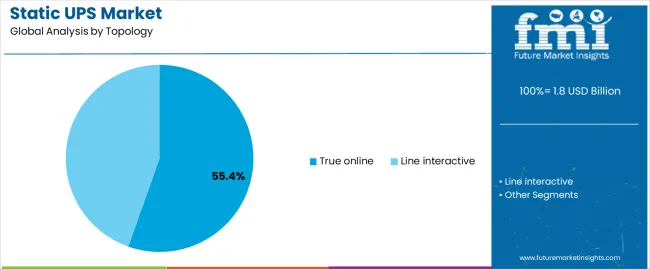
Market Position: True online UPS systems command the leading position in the Static UPS market with approximately 55.4% market share through advanced power conditioning properties, including continuous power conversion, zero transfer time capability, and operational optimization that enable facility managers to achieve optimal equipment protection across diverse commercial and industrial environments.
Value Drivers: The segment benefits from facility operator preference for reliable UPS systems that provide consistent power quality, reduced equipment damage, and operational continuity without requiring significant infrastructure modifications. Advanced topology features enable automated power management, protection consistency, and integration with existing electrical equipment, where power conditioning and operational reliability represent critical facility requirements.
Competitive Advantages: True online UPS systems differentiate through proven double-conversion architecture, consistent voltage regulation, and integration with automated facility systems that enhance operational effectiveness while maintaining optimal power quality suitable for diverse critical equipment applications.
Key market characteristics:
Line interactive UPS systems maintain cost-effective topology positioning in the Static UPS market due to their economical power protection properties and versatile application advantages. These systems appeal to facility managers requiring standard backup capability with adequate performance for mainstream commercial applications. Market adoption is driven by small business expansion, emphasizing reliable power solutions and operational efficiency through optimized UPS technology while maintaining competitive pricing structures.
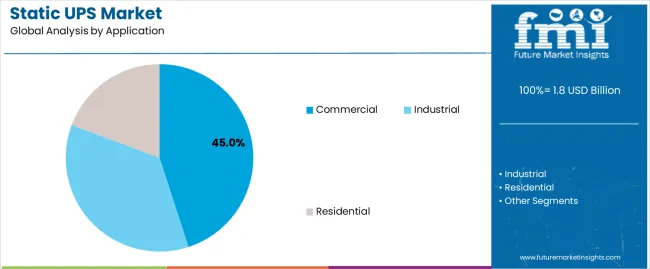
Market Context: Commercial applications dominate the Static UPS market with approximately 45.0% market share due to widespread adoption of reliable power protection and increasing focus on equipment preservation, operational continuity, and facility management applications that minimize downtime while maintaining building operational standards.
Appeal Factors: Commercial facility managers prioritize power reliability, protection consistency, and integration with existing building infrastructure that enables coordinated backup application across multiple equipment systems. The segment benefits from substantial facility construction investment and infrastructure programs that emphasize the acquisition of UPS systems for equipment protection and operational continuity applications.
Growth Drivers: Commercial building expansion programs incorporate static UPS systems as standard equipment for critical facility operations, while technology infrastructure growth increases demand for reliable power capabilities that comply with operational standards and minimize business interruption.
Market Challenges: Varying facility standards and equipment power requirements may limit UPS standardization across different building types or operational scenarios.
Application dynamics include:
Industrial applications capture approximately 35.0% market share through specialized power requirements in manufacturing facilities, process automation, and production equipment applications. These facilities demand robust UPS systems capable of protecting sensitive equipment while providing exceptional operational continuity and production uptime capabilities.
Residential applications account for approximately 20.0% market share, including home backup systems, personal equipment protection, and household power security requiring UPS capabilities for consumer electronics and essential home systems.
Growth Accelerators: Commercial construction expansion drives primary adoption as static UPS systems provide superior equipment protection capabilities that enable facility managers to meet stringent uptime standards without excessive infrastructure costs, supporting building operations and business continuity missions that require precise power backup applications. Electrical infrastructure reliability demand accelerates market expansion as facility operators seek effective power conditioning systems that minimize equipment damage while maintaining operational effectiveness during voltage events and outage scenarios. Facility technology spending increases worldwide, creating sustained demand for power protection systems that complement traditional electrical processes and provide operational continuity in critical environments.
Growth Inhibitors: Initial investment cost challenges vary across UPS suppliers regarding the pricing of power electronics and battery systems, which may limit operational flexibility and market penetration in regions with budget constraints or cost-sensitive facility operations. Technical performance limitations persist regarding battery maintenance requirements and replacement costs that may reduce effectiveness in long-term deployment or remote facility conditions, affecting total ownership costs and operational requirements. Market fragmentation across multiple facility standards and power requirements creates compatibility concerns between different UPS suppliers and existing electrical infrastructure.
Market Evolution Patterns: Adoption accelerates in commercial data centers and industrial manufacturing sectors where operational continuity justifies UPS investment costs, with geographic concentration in developed markets transitioning toward mainstream adoption in emerging economies driven by infrastructure expansion and power quality awareness. Technology development focuses on enhanced power topologies, improved battery integration, and compatibility with renewable energy systems that optimize equipment protection and facility effectiveness. The market could face disruption if alternative power backup technologies or energy storage innovations significantly limit the deployment of traditional UPS systems in facility applications, though static UPS technology's unique combination of power conditioning, zero transfer time, and equipment protection continues to make it preferred in critical applications.
The Static UPS market demonstrates varied regional dynamics with Growth Leaders including China (5.4% CAGR) and India (5.0% CAGR) driving expansion through commercial construction capacity additions and infrastructure protection programs. Steady Performers encompass Germany (4.6% CAGR), Brazil (4.2% CAGR), and USA (3.8% CAGR), benefiting from established facility infrastructure and advanced power protection adoption. Mature Markets feature UK (3.4% CAGR) and Japan (3.0% CAGR), where specialized critical facility applications and power quality integration support consistent growth patterns.
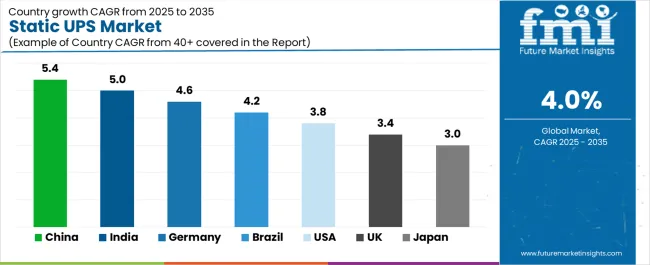
| Country | CAGR (2025-2035) |
|---|---|
| China | 5.4% |
| India | 5.0% |
| Germany | 4.6% |
| Brazil | 4.2% |
| USA | 3.8% |
| UK | 3.4% |
| Japan | 3.0% |
Regional synthesis reveals Asia Pacific markets leading adoption through commercial infrastructure expansion and power protection technology development, while European countries maintain steady expansion supported by facility technology advancement and electrical standardization requirements. North American markets show moderate growth driven by data center applications and critical facility integration trends.
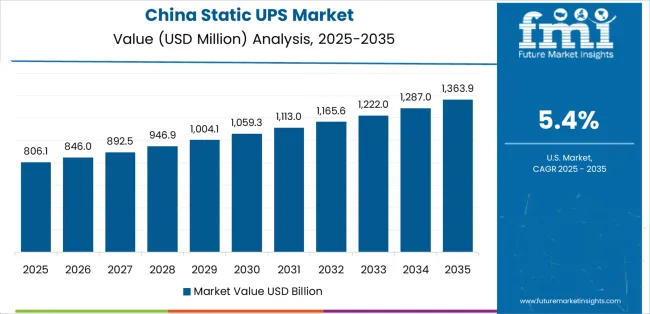
The Chinese market emphasizes advanced power features, including precision conditioning control and integration with comprehensive facility management platforms that manage equipment protection, voltage optimization, and reliability applications through unified monitoring systems. The country demonstrates strong growth at 5.4% CAGR, driven by commercial construction expansion, infrastructure modernization initiatives, and emerging technology facility development that support UPS integration. Chinese facility managers prioritize operational effectiveness with static UPS systems delivering consistent equipment protection through advanced power capabilities and facility adaptation features.
Technology deployment channels include major commercial developers, specialized power equipment suppliers, and facility management programs that support professional applications for complex data center protection and telecommunications backup applications. Building platform integration capabilities with established electrical systems expand market appeal across diverse operational requirements seeking reliable power and continuity benefits. The expanding commercial construction base and accelerating technology infrastructure create sustained demand, while innovative applications in renewable energy and smart buildings open new growth avenues.
Performance Metrics:
Germany's advanced industrial market demonstrates sophisticated UPS deployment with documented operational effectiveness in commercial facility applications and manufacturing operations through integration with existing electrical systems and facility infrastructure. The country leverages engineering expertise in power quality and facility systems integration to maintain strong growth at 4.6% CAGR. Industrial centers, including Frankfurt, Munich, and Hamburg, showcase premium installations where UPS systems integrate with comprehensive facility platforms and equipment management systems to optimize operational continuity and protection effectiveness.
German facility operators prioritize system reliability and EU compliance in UPS development, creating demand for advanced power systems with monitoring features, including remote management and automated protection systems. The market benefits from established facility infrastructure and a willingness to invest in power quality technologies that provide long-term operational benefits and compliance with international electrical and reliability standards.
Market Intelligence Brief:
The USA static UPS market demonstrates sophisticated deployment across commercial applications with documented effectiveness in data center protection and critical facility operations through integration with comprehensive power management systems and backup infrastructure. The country leverages advanced technology capabilities in facility automation and equipment protection technologies to maintain moderate growth at 3.8% CAGR. Industrial centers, including Silicon Valley, Texas, and Virginia, showcase premium installations where UPS systems integrate with comprehensive data center platforms and telecommunications networks to optimize operational continuity and protection effectiveness.
American facility operators prioritize power reliability and operational continuity in UPS development, creating demand for advanced monitoring systems with features, including predictive maintenance and automated management systems. The market benefits from established data center infrastructure and willingness to invest in power protection technologies that provide long-term operational benefits and compliance with facility and electrical standards.
Market Intelligence Brief:
The UK static UPS market demonstrates advanced reliability deployment with documented operational effectiveness in commercial facility applications and critical infrastructure operations through integration with existing electrical compliance systems and facility infrastructure. The country leverages regulatory expertise in power quality and facility systems integration to maintain steady growth at 3.4% CAGR. Industrial centers, including London, Manchester, and Edinburgh, showcase installations where UPS systems integrate with comprehensive facility platforms and equipment management systems to optimize operational compliance and protection effectiveness.
British facility operators prioritize system reliability and regulatory compliance in UPS development, creating demand for certified power systems with features, including performance monitoring and standards integration. The market benefits from established commercial infrastructure and commitment to invest in power quality technologies that provide long-term operational benefits and compliance with UK and EU electrical standards. Data center applications, telecommunications systems, and critical facility programs drive diversified demand across multiple application segments.
Strategic Market Indicators:
India's static UPS market demonstrates rapid expansion deployment with documented operational effectiveness in commercial facility applications and infrastructure operations through integration with emerging electrical systems and building development infrastructure. The country leverages growing industrial capabilities in facility technology and power systems integration to achieve high growth at 5.0% CAGR. Industrial centers, including Mumbai, Bangalore, and Delhi, showcase expanding installations where UPS systems integrate with comprehensive facility platforms and equipment networks to optimize market penetration and protection effectiveness.
Indian facility managers prioritize reliability positioning and operational standards in UPS development, creating demand for dependable power systems with features, including automated monitoring and protection systems. The market benefits from expanding commercial infrastructure and willingness to invest in international-standard power technologies that provide operational continuity and compliance with global facility standards.
Market Intelligence Brief:
Japan's static UPS market demonstrates precision deployment with documented operational effectiveness in critical facility applications and technology operations through integration with advanced electrical systems and quality control infrastructure. The country leverages engineering excellence in power quality and facility systems integration to maintain steady growth at 3.0% CAGR. Industrial centers, including Tokyo, Osaka, and Nagoya, showcase installations where UPS systems integrate with comprehensive quality platforms and operational systems to optimize equipment excellence and protection effectiveness.
Japanese facility operators prioritize system precision and reliability excellence in UPS development, creating demand for high-quality power systems with features, including precision voltage regulation and quality integration systems. The market benefits from established technology infrastructure and commitment to invest in highest-quality power technologies that provide superior operational positioning and compliance with stringent Japanese reliability standards.
Strategic Market Indicators:
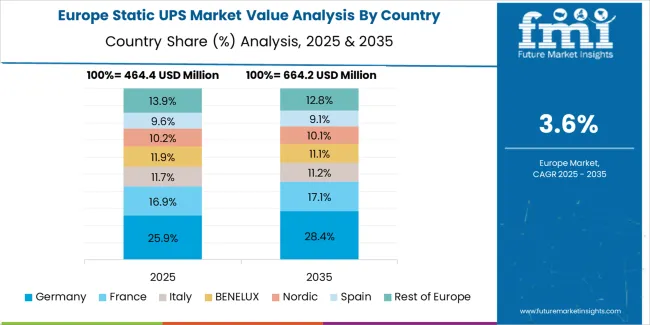
The Static UPS market in Europe is projected to grow substantially over the forecast period, with Germany expected to maintain its leadership position with a significant market share supported by its advanced facility infrastructure and major commercial centers in Frankfurt and Munich. UK follows with strong market presence, driven by comprehensive data center programs and critical facility initiatives. France holds substantial market share through specialized commercial building activities, infrastructure applications, and technology facility construction.
Italy commands notable market presence through strong industrial facility and commercial building projects. Spain accounts for growing market share aided by infrastructure expansion and facility technology adoption. The Netherlands maintains steady share driven by specialty data center applications and power quality demand. The Rest of Europe region is anticipated to show steady adoption, reflecting consistent growth in Nordic countries, commercial facility expansion in Central European markets, and infrastructure upgrades across Eastern European technology facilities.

In Japan, the Static UPS market prioritizes true online systems, which capture the dominant share of critical facility and data center installations due to their advanced features, including precision power conditioning optimization and seamless integration with existing facility infrastructure. Japanese facility operators emphasize reliability, precision, and long-term operational excellence, creating demand for true online UPS systems that provide consistent power protection capabilities and superior conditioning performance based on operational requirements and quality standards. Line interactive maintains secondary positions primarily in small commercial applications and standard facility installations where adequate power protection meets operational requirements without compromising facility efficiency.
Market Characteristics:
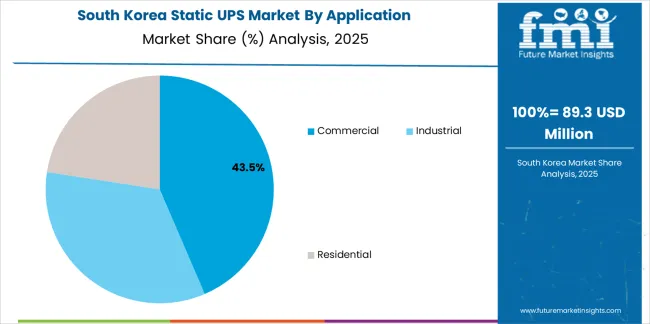
In South Korea, the market structure favors international power manufacturers, including Eaton, Vertiv, and Emerson Network Power, which maintain dominant positions through comprehensive product portfolios and established facility networks supporting both commercial building and industrial facility installations. These providers offer integrated solutions combining advanced UPS systems with professional installation services and ongoing technical support that appeal to Korean facility operators seeking reliable power protection systems. Local electrical contractors and system integrators capture moderate market share by providing localized service capabilities and competitive pricing for standard facility installations, while domestic manufacturers focus on specialized applications and cost-effective solutions tailored to Korean market characteristics.
Channel Insights:
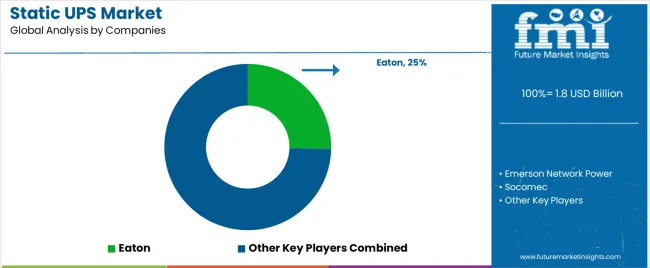
The Static UPS market operates with moderate concentration, featuring approximately 10-12 meaningful participants, where leading companies control roughly 50-55% of the global market share through established facility relationships and comprehensive power protection portfolios. Competition emphasizes advanced topology capabilities, system reliability, and facility integration rather than price-based rivalry. The leading company, Eaton, commands approximately 25.4% market share through its extensive UPS product line and global facility presence.
Market Leaders encompass Eaton, Vertiv, and Emerson Network Power, which maintain competitive advantages through extensive power protection expertise, global facility networks, and comprehensive system integration capabilities that create customer loyalty and support premium pricing. These companies leverage decades of power technology experience and ongoing innovation investments to develop advanced UPS systems with precision power conditioning and reliability features. Technology Innovators include ABB and regional specialists, which compete through specialized topology focus and innovative power capabilities that appeal to facility operators seeking advanced protection solutions and operational continuity.
These companies differentiate through rapid technology development cycles and specialized critical facility application focus. Regional Specialists feature power manufacturers focusing on specific geographic markets and specialized applications, including renewable energy systems and integrated facility solutions. Market dynamics favor participants that combine reliable power topologies with advanced monitoring capabilities, including precision conditioning control and automatic facility optimization features. Competitive pressure intensifies as traditional electrical equipment suppliers expand into facility UPS systems, while specialized power protection companies challenge established players through innovative topology solutions and smart platforms targeting commercial and industrial segments.
| Item | Value |
|---|---|
| Quantitative Units | USD 1.8 billion |
| Topology | True online, Line interactive |
| Application | Commercial, Industrial, Residential |
| Regions Covered | Asia Pacific, Europe, North America, Latin America, Middle East & Africa |
| Countries Covered | China, India, Germany, Brazil, USA, UK, Japan, and 20+ additional countries |
| Key Companies Profiled | Eaton, Emerson Network Power, Socomec, GE, Legrand, Vertiv, Indus Powers, Genus Innovation, Gesab, ABB, Mitsubishi Electric, Piller |
| Additional Attributes | Dollar sales by topology and application categories, regional adoption trends across Asia Pacific, Europe, and North America, competitive landscape with power equipment manufacturers and facility suppliers, operator preferences for reliability and power quality, integration with facility management platforms and equipment monitoring systems, innovations in power topology and conditioning excellence, and development of automated protection solutions with enhanced performance and operational optimization capabilities. |
The global static UPS market is estimated to be valued at USD 1.8 billion in 2025.
The market size for the static UPS market is projected to reach USD 2.7 billion by 2035.
The static UPS market is expected to grow at a 4.0% CAGR between 2025 and 2035.
The key product types in static UPS market are true online and line interactive.
In terms of application, commercial segment to command 45.0% share in the static UPS market in 2025.






Full Research Suite comprises of:
Market outlook & trends analysis
Interviews & case studies
Strategic recommendations
Vendor profiles & capabilities analysis
5-year forecasts
8 regions and 60+ country-level data splits
Market segment data splits
12 months of continuous data updates
DELIVERED AS:
PDF EXCEL ONLINE
Static VAR Compensator Market Forecast Outlook 2025 to 2035
Static Stability Control Sensors Market Analysis - Size, Share, and Forecast Outlook 2025 to 2035
Static Random Access Memory (SRAM) Market Size and Share Forecast Outlook 2025 to 2035
Static Synchronous Compensator (STATCOM) Market Size and Share Forecast Outlook 2025 to 2035
Static-Free Packaging Films Market Growth - Demand & Forecast 2025 to 2035
Isostatic Pressing Market Analysis by Component, Type, and Region: Forecast for 2025 to 2035
Diastatic Malt Market
Prostatic arterial embolization (PAE) Market
Hemostatic Gels Market Analysis - Size, Share, and Forecast Outlook 2025 to 2035
Antistatic Brush Market Growth – Trends & Forecast 2024-2034
Metastatic Bone Tumor Treatment Market
Anti-Static Hair Care Products Market Analysis - Size and Share Forecast Outlook 2025 to 2035
Anti-Static Liners Market Size and Share Forecast Outlook 2025 to 2035
Anti-Static Foam Pouch Market Size and Share Forecast Outlook 2025 to 2035
Anti-Static Agents Market Size and Share Forecast Outlook 2025 to 2035
Anti-Static Control Products Market Size and Share Forecast Outlook 2025 to 2035
Anti-Static Foam Packaging Market Size, Share & Forecast 2025 to 2035
Anti-static Backing Paper Market Analysis - Size, Share, and Forecast Outlook 2025 to 2035
Anti-Static Bubble Pouch Market – Trends & Forecast 2025 to 2035
Anti-Static Fibres Market Growth – Trends & Forecast 2025 to 2035

Thank you!
You will receive an email from our Business Development Manager. Please be sure to check your SPAM/JUNK folder too.
Chat With
MaRIA